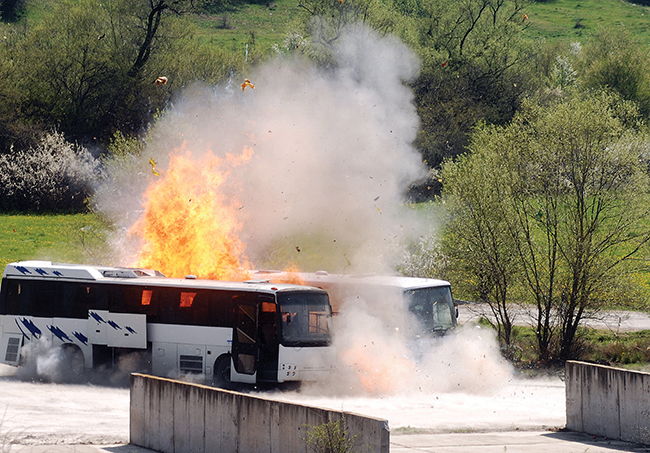
By Al Daoud
Operating buses presents many unique challenges, but one challenge is far more important than the rest: passenger safety. You carefully select the best drivers, buy quality equipment and make it clear to your passengers and company that safety is a priority. You plan for every outcome imaginable, including bus fires. But how much emphasis do you place on fire prevention? Does your vehicle maintenance program include fire prevention measures? Do you tell your drivers what fire hazards to look for during their pre- and post-trip inspections?
According to a study completed by the National Fire Protection Association (NFPA), from 1999 to 2003, U.S. fire departments responded to an estimated average of 2,210 bus fires per year. On average, six bus fires were reported every day. These fires caused an estimated average of three deaths, 30 injuries and $24.2 million in direct property damage per year. However, these figures can be deceiving. The fires used in these statistics are only the bus fires that were reported and responded to by emergency services. It is likely that many more fires occurred, but went unreported for a variety of reasons. Minor fires may take place much more frequently than the type of incidents that are reported, but every one of these situations could have much bigger consequences.
The cost and severity of bus fires vary. However, bus fires have the potential to be catastrophic. They have a much larger impact when you consider potential damage to your company’s reputation. Follow these three important steps to avoid fires losses:
1. Properly maintain your vehicles
Prevention is the key to avoiding large fire losses, and good vehicle maintenance is vital to vehicle fire prevention. To prevent most causes of vehicle fires, ensure tires are properly inflated, brakes are adjusted appropriately, engines are clean and free of fluid leaks, electrical wiring is undamaged and wheel bearings are properly maintained. Make sure these items are inspected and maintained by your mechanics and instruct your drivers to pay attention to these items during their pre- and post-trip inspections.
2. Install fire suppression and fire monitoring systems
A fire can also develop undetected in the engine compartment or wheel wells, as the driver cannot smell or see the smoke. Once it has reached a sufficient size, the fire can spread into the cabin. At this stage, a fire will be virtually immune to the driver’s fire extinguisher and can quickly engulf the cabin. A quality fire suppression system located in the engine compartment will help to eliminate small fires before they can cause significant damage.
Fire suppression and fire monitoring systems are available for buses and come in many different configurations. These systems can be retrofitted into existing equipment by your maintenance staff and can quickly detect and extinguish fires in the engine compartment. Some of these systems, like those offered by FireTrace, require no power to operate and are very simple, affordable, adaptable and most importantly, effective.
3. Provide drivers with emergency training
Your drivers should be trained to stop in the safest location possible and evacuate the vehicle if the fire suppression system activates or if they feel that a fire has started. Even if the fire is extinguished, the cause, such as an oil drip on an exhaust manifold, may still be present and could reignite further down the road.
Before your drivers leave for long trips and before leaving major stops, they should share a pre-trip safety message with passengers that includes proper seat belt use, emergency exits and emergency protocol. Train your drivers to control a fire situation. Provide them with guidelines to instruct passengers, prevent panic and assemble passengers in a safe location. Remind your drivers that passengers do not need to come into contact with flames to be injured; death or illness from smoke inhalation and injuries caused by panicked evacuations can also occur. Make sure your drivers know to get their passengers away from the vehicle as soon as possible. The area around the outside of the bus may be hazardous due to the smoke and possible explosions from fuel tanks, batteries and tires.
By following the above guidelines, you should never have to experience a major vehicle fire loss. Remember to train, retrain and test your drivers on this topic periodically to ensure that they continue to practice prevention techniques and will always be ready to respond to a vehicle fire if one occurs.
Al Daoud serves as Loss Prevention & Safety Services Team Lead for Protective Insurance. Visit www.protectiveinsurance.com.
